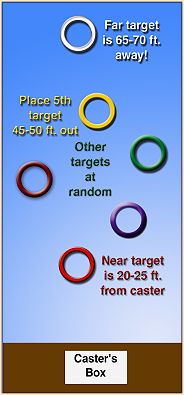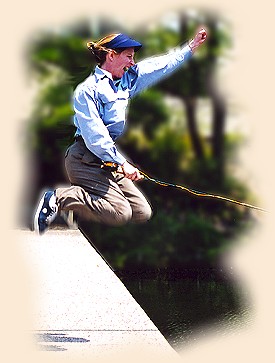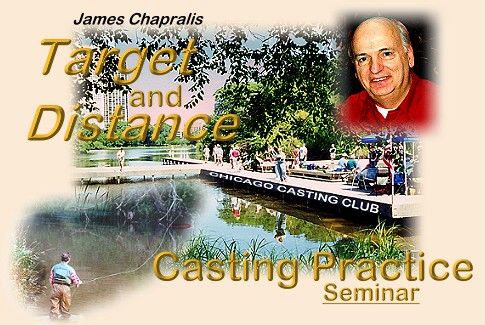|
In order to enjoy better fishing results, it is necessary
for most anglers to practice casting on a continuing basis. Admittedly,
practice is b-o-r-i-n-g, so it's my job to make casting practice so
much fun that you'll almost like it as much as fishing! And down the
road you might even want to enter a casting tournament! And Win!
LESSON FIVE: The Bass-Bug Event
To review: To succeed in fly fishing, we need to become
good casters primarily in terms of accuracy, but also, under
certain circumstances, in distance. In our introduction,
we mentioned that most of us learn the fundamentals of
casting through books or videos, casting schools, or,
perhaps, from a veteran fly-casting friend. But between
fishing trips, these lessons are lost, so it is necessary
to practice our casting periodically. We agreed that usually
practice isn't fun, but we're going to make casting practice
"fun," to a point that many of us will actually look forward to it.
The Dry-Fly and Trout-Fly Events (Lessons Three and Four) focus
on casting small flies at reasonable distances. How about an
event for anglers who like to toss poppers or bigger flies
or streamers for bass, pike, muskies and even snook or other
saltwater species?
Well, we've got just the event for you. The fascinating, challenging
Bass-Bug Event.

PLACING THE TARGETS: Remember in Lesson Two when we told you to
obtain or make six 30-inch targets? So far we've only used five
targets. Here's where we use the sixth target. Use the same
setup for the first five targets that we used for the Dry-Fly
Event (Lesson Three), and place the sixth target 65 to 70 feet
from the caster's box. Yeah, you're right! That's going to be
a tough cast all right.
THE TACKLE: We'll use heavier gear than what we recommended
for the two previous events, because we're going to cast a
bass popper, which is a lot more air resistant and heavier
than a dry fly. Here are our recommendations for this event:
The Rod: A nine-foot fly rod calibrated to take a
No. 8 or a 9 fly line is ideal. If you don't have a nine footer
but have an 8½-ft. fly rod that takes a No. 8 line use it.
The Line: A No. 8 or 9 forward tapered floating
line is best.
The Reel: Your normal single-action fly reel
is best.
The Leader: At least 6-ft. in length tapered
from about .026" to about .013" or less.
The Bug: Use a cork body bass bug. The cork
body should be at least ¾ inch in length and no less than ½
inch in diameter. The hair tail should be an inch or longer.
The ideal color for visibility is yellow, and, of course, be
sure to remove the point and barb to avoid any accidents.

HOW TO CAST THE BASS-BUG EVENT
To start with strip sufficient line from your reel so that it
is at least ten feet beyond the far target which is about 65
to 70 feet away. Now strip in all the line (don't reel it in)
so that you have about two feet of fly line and leader beyond
the rod tip.
Round One: Start your false casting so that the line,
leader and bug are moving back and forth in the air, without
intentionally striking the surface in front or in back of you.
While false casting, as per the two previous lessons, let
sufficient line pass through the rod guides, until you think
you have enough line out to hit the first target. If you let
out too much line, strip some in while false casting. After
adjustments are made, and your bass bug seems to hover above
the near target on your false cast, make the final forward
presentation and allow the bug to settle on the target. Put
some force behind the forward cast. You don't have to make a
delicate presentation. You want to straighten out that leader.
Let's go to the second target. Lift the bug off the ground or
water and begin false casting again over the second target. Let
out line through the guides as needed. If you let out too much
line, strip some in. When you think the bug will land in the
center of the target, make your forward cast (presentation)
and drop the popper on the target. Easy, huh? Okay, here's
the catch. Except for the first target, you can only make
two false casts between the remaining targets. In other words,
you have to adjust the amount of line out quickly.
Now proceed to the third target, fourth and fifth target. You'll
notice that the distant targets are harder to hit.
Why only two false casts? Suppose you're fishing and you notice
a marauding bass chasing some minnows just beyond your popper.
If you make a lot of false casts that fish is LG (long gone).
You got to deliver the bass bug accurately, decisively and quickly.
After you make your cast to the fifth target you've got the long
one! That's a real toughie! Unless you are a very good caster (or
very lucky), that last target is a killer. And remember you can
only make two false casts between targets!
That takes care of the first round. Now strip in line (don't reel
it in) until you have only about two feet of line and the leader
beyond the rod tip and the hookless bass bug is in your non-casting
hand.
Round Two: You do the same thing as before. Make as many
false casts as you'd like to the close target and make your
presentation. You're going to cast to the next five targets
in the same sequence as in Round One, but on this round you
will only make one false cast between the targets. I know
it's tough, but these events are designed to improve your
casting by challenging your skills to the max.
That sixth target-where you go from 45-50 feet to 65-70 feet
with one false cast-is a button buster. You need to know the
double haul (or single haul at the minimum).
 Why is Cathy Sero jumping with joy? Because
she cast from the white target (50 ft.) to the yellow (65 ft.)
with one false cast as required in the Bass-Bug event at the
2001 Illinois State Casting Championship!
I said at the beginning this event is a difficult, demanding
event. But the purpose of these "games" is to make you the
very best caster you can possibly be and if you practice these
casting exercises you will see a constant improvement and the
rewards are twofold: You will enjoy the effortless casting while
fishing, and your angling success will definitely improve.
You'll feel an absolute "high" when you deliver that popper
next to that stump 70 feet away!
Why is Cathy Sero jumping with joy? Because
she cast from the white target (50 ft.) to the yellow (65 ft.)
with one false cast as required in the Bass-Bug event at the
2001 Illinois State Casting Championship!
I said at the beginning this event is a difficult, demanding
event. But the purpose of these "games" is to make you the
very best caster you can possibly be and if you practice these
casting exercises you will see a constant improvement and the
rewards are twofold: You will enjoy the effortless casting while
fishing, and your angling success will definitely improve.
You'll feel an absolute "high" when you deliver that popper
next to that stump 70 feet away!
Caution: You have to be careful in lifting
up the line from second far target (45-50 ft.) to cast the
far target so that you don't damage the rod. Yes, it requires
some oomph but you have to learn to peel the line from the
surface and at the same time accelerate the back cast with
the single haul. Again refer to the casting instruction
books and videos on single and double haul.
If you having problems reaching the distant targets move them
in five to ten feet and adjust the others accordingly. Then
as you gain casting efficiency and confidence move them out.
Some fly casting outfits were not built to cast a bass bug
50 to 70 feet. Don't try to do this event with your No. 5 or
6 trout fishing outfit!
SCORING: : There is one demerit for each foot or fraction
the bug misses the target for the first five targets, with a
maximum of two demerits. See, the people who designed these
rules have some compassion after all. Well, not quite, because
on the last target, the one that's way out there, they increased
the maximum demerits to five to both rounds. Obviously that
last target is extremely important. There are other demerits:
Each tick gives you one demerit, and if you make more false
casts than the allotted number (two false casts in first round
and one false cast in second round), you're charged with one
demerit for each additional false cast.
YOUR SCORE: As we mentioned previously, it's important
to keep track of your scores, so that you can see your improvement
with casting practice.
As per previous lessons, here's my arbitrary rating for the
Bass-Bug Event. (We'll not count ticks or demerits for
additional false casts here.)
Under 70: Something is wrong here. If you miss every
target by the max your score would be 70, since we're not
counting ticks and additional false casts here.
71 to 75: Hey, this is a tough event. You'll get the
hang of it.
76 to 83: You've got the basics and all you need to do
is practice.
84 to 90: You're casting very well! Good eye-and-hand
coordination. Terrific!
91 to 95: Superb! You are an excellent caster.
96 to 100 (Super-Elite Class): If you are making the
right number of false casts and not ticking, you are ACA
National Casting Tournament Championship material! You're
among the top 1 percent of fly casters in the world! Very
few of the top casting instructors are going to score in
this bracket!
HOW DOES THE BASS BUG EVENT HELP OUR FISHING? If you use
big flies (bass bugs, poppers, large streamers, etc.,) this
event will help you immensely. One of the lessons you will
learn is that you will have to wait longer on your back cast
than you normally would if you were casting small trout flies.
Being able to pick up a lot of line and deliver a long accurate
cast is certainly very helpful in just about any sight saltwater
fly-fishing application. Bonefishing. Tarpon. Snook. Redfish.
The same applies to sight freshwater fishing. Big northern pike
or muskies cruising the shallows. Steelhead. Salmon. Just
about every species.
We've all had the experience that no matter how much power
we were able to put into the cast, we were six to ten feet
short of a feeding fish. Frustrating, right? We eventually
find out that it is timing that becomes more important rather
than "muscle."
You'll quickly learn the importance of good back cast, loading
a rod, double haul, how to pick up a longer line, how to cast
an air resistant large fly or popper with accuracy and many
lessons that are so necessary in many fishing presentations.
THE CHAMPS: After you try this event a few times, you
probably wonder what type of scores win in the ACA National
Tournament produce? Usually, 96 and above, and yes, there
have been some perfect scores. Amazingly, Luke Brugnara,
when he was an intermediate caster (age 13 to 16), cast a
perfect score! And remember, they are doing it under the
pressure of competition!
Next Week: The Angler's Distance Fly. Enough about
accuracy. You want to be able to cast a long line. Well, get
ready, but in the meantime learn the mechanics of the double
haul. One of the best places? Take a look at James Castwell's
articles. Click on The Double Haul
found in the 2nd Quarter 2001 in the Castwell Archives.
About Jim:
Jim Chapralis is a world traveler, a pioneer in the international fishing
travel business, and author, most recently of Fishing Passion, reviewed in
our Book Review section. He is an avid angler - and caster.
Currently involved with the 94th Annual National Casting
Tournament July 29 to August 3, 2002. You can reach Jim via his
website www.AnglingMatters.com
|


 Why is Cathy Sero jumping with joy? Because
she cast from the white target (50 ft.) to the yellow (65 ft.)
with one false cast as required in the Bass-Bug event at the
2001 Illinois State Casting Championship!
I said at the beginning this event is a difficult, demanding
event. But the purpose of these "games" is to make you the
very best caster you can possibly be and if you practice these
casting exercises you will see a constant improvement and the
rewards are twofold: You will enjoy the effortless casting while
fishing, and your angling success will definitely improve.
You'll feel an absolute "high" when you deliver that popper
next to that stump 70 feet away!
Why is Cathy Sero jumping with joy? Because
she cast from the white target (50 ft.) to the yellow (65 ft.)
with one false cast as required in the Bass-Bug event at the
2001 Illinois State Casting Championship!
I said at the beginning this event is a difficult, demanding
event. But the purpose of these "games" is to make you the
very best caster you can possibly be and if you practice these
casting exercises you will see a constant improvement and the
rewards are twofold: You will enjoy the effortless casting while
fishing, and your angling success will definitely improve.
You'll feel an absolute "high" when you deliver that popper
next to that stump 70 feet away!
